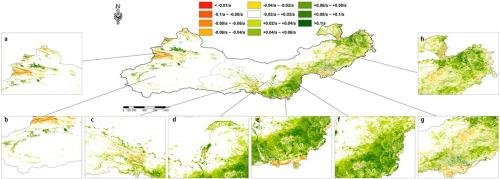Ecological Indicators ( IF 6.9 ) Pub Date : 2020-09-17 , DOI: 10.1016/j.ecolind.2020.106932 Yungang Hu , Huan Li , Dan Wu , Wei Chen , Xiang Zhao , Miaole Hou , Aijia Li , Yujiao Zhu

|
The Three-North Shelter Forest Program (TNSFP) region of China is an important ecological region covering more than 42.4% of China’s land area. Several ecological restoration projects have been implemented in this region, but evaluation work is relatively limited partly due to the selection of suitable remote sensing products. In this study, leaf area index is proposed as a suitable indicator to evaluate the ecological restoration situation as it is an indicator reflects the growth of green vegetations. The Global Land Surface Satellite (GLASS) LAI dataset and land cover dataset from 2000 to 2015 were adopted and analyzed in this study. The forest cover area slightly increased, while the grassland area decreased. Although large-scale forestation movements were carried out across the entire TNSFP region, the forest growth conditions mainly improved in regions with an annual precipitation greater than 400 mm. Furthermore, LAI-precipitation correlations were very high (r greater than 0.6) in the regions across 400 mm isohyets, but lower (r < 0.4) far away from 400 mm isohyets. In relatively arid regions, forest growth did not show an obvious increase trend and sometimes a decrease trend. The increase in the LAI of these regions was mainly due to the restoration of grassland. Therefore, although LAI in most of the TNSFP region showed increasing trends, it is still not sufficient to state that these trends were caused by forestation projects in China.


























 京公网安备 11010802027423号
京公网安备 11010802027423号